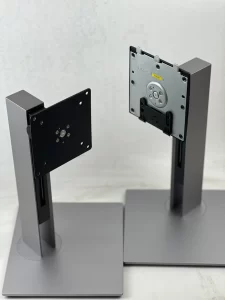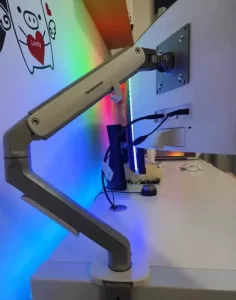Your computer monitor stand breaking is an awkward situation that many might encounter. Suddenly, your monitor can’t stand stably, turning your entire workspace into chaos, leaving you wondering what to do next. But don’t worry! Whether you’re looking to fix it or find a temporary solution, there are practical ways to help you out.
How important are monitor stands?

Monitor stands play a vital role in creating a comfortable and ergonomic workstation, which can have direct implications for productivity, health, and overall user experience. Here’s why they are important:
- Ergonomics:
- Proper monitor positioning reduces the risk of neck, back, and eye strain. An ideal monitor stand allows users to position the screen at eye level and at an appropriate distance to prevent leaning forward or looking down.
- Adjustability:
- Many monitor stands allow for height, tilt, swivel, and pivot adjustments. This flexibility ensures that users can set their monitor at the best angle and height for their seating position and desk height.
- Space Management:
- Monitor stands, especially those with an elevated design or built-in storage, can help free up valuable desk space, providing a cleaner, more organized workspace.
- Multiple Monitors:
- For users with multi-monitor setups, specialized dual or triple monitor stands enable better screen alignment and more efficient use of desk space.
- Ventilation:
- Elevating a monitor ensures better ventilation for screens, especially for all-in-one computers where the hardware is behind the display. This can prolong the life of the device by ensuring it doesn’t overheat.
- Reduced Clutter:
- Some stands come with cable management features, which allow users to route monitor cables neatly, reducing clutter and tangling.
- Aesthetics:
- A good monitor stand can enhance the look of a workstation. There are numerous stylish and sleek designs available that can complement the overall décor of an office or room.
- Protection:
- Elevating the monitor can reduce the risk of it being knocked over, spilled on, or bumped.
While it’s possible to use a monitor without a dedicated stand—by propping it on books or other makeshift platforms, for instance—a quality monitor stand is a worthwhile investment for anyone spending significant time in front of a screen. It not only ensures comfort but also promotes better posture and overall health in the long run.
What can I Use Instead of a Monitor Stand?

If your monitor stand breaks, there are several solutions you can consider:
- Wall Mount: If your monitor has VESA mount holes, you can attach it to a wall mount. This will free up desk space and can offer more flexibility in monitor positioning.
- Monitor Arms: These are adjustable arms that clamp to the back of your desk. They can hold one or multiple monitors and allow for easy repositioning.
- Books or Boxes: In a pinch, you can prop up your monitor on a stack of books or a sturdy box to get it to the desired height. However, this is more of a temporary solution.
- DIY Stand: You can create a stand using materials like wood, metal, or even Lego. There are numerous online tutorials available to help guide your project.
- Floating Desks or Shelves: Installing a shelf or using a floating desk can provide an elevated platform for your monitor.
- Laptop Stand: If you’re using a small monitor or a portable display, a laptop stand can elevate it to the right viewing height.
- Adjustable Desk: Height-adjustable desks can help you get your monitor to the perfect viewing height without needing a separate stand.
- Purchase a Replacement Stand: If your monitor’s original stand breaks, you might be able to buy a replacement stand from the manufacturer or a third-party stand that’s compatible.
- Integrated Furniture: Some desks come with built-in raised platforms for monitors.
How do You Fix a Loose Monitor Stand?
If your monitor stand has become loose, it can be both inconvenient and potentially hazardous. Here are some steps you can take to fix it:
- Tighten Screws or Bolts:
- Most monitor stands are held together by screws or bolts. Over time, these can become loose due to the movement and adjustments of the monitor.
- Turn off and unplug the monitor for safety.
- Check all screws, bolts, or fasteners on the stand and tighten any that are loose using a screwdriver or wrench.
- Check the Bracket:
- Some monitors attach to their stands with a bracket or clasp mechanism.
- Ensure the bracket is correctly seated and securely locked into place.
- Inspect for Damaged Components:
- Sometimes, the components of the stand or the monitor itself can become worn or damaged, causing the stand to feel loose.
- Look for signs of wear, cracks, or broken parts.
- If a part is damaged, it may need to be replaced. Check with the manufacturer for replacement parts or consider purchasing a third-party stand.
- Add Rubber or Felt Pads:
- If the base of the stand is loose or wobbly on the desk, adding rubber or felt pads might stabilize it. These pads can be found at hardware or craft stores and can be stuck to the bottom of the stand.
- Brace the Stand:
- In a pinch, you can brace the monitor against a wall or another object to prevent it from tipping. This isn’t a long-term solution but can be a quick fix.
- Consider a Wall Mount or Monitor Arm:
- If your monitor’s stand continues to be an issue, you might consider investing in a wall mount or a monitor arm. These can provide more stability and flexibility than some stock monitor stands.
Always remember to handle monitors with care. If you’re adjusting or inspecting the stand, it’s a good idea to lay the monitor face down on a soft, clean surface to avoid scratches or damage.
